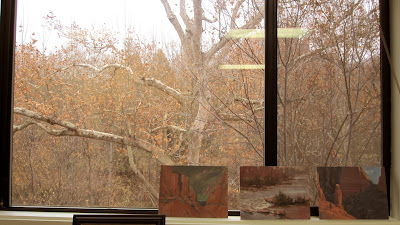I've painted Munds Mountain many times over the years, and from the parking lot where I paint it, its mass is nearly always backlit. Toward the afternoon hours, a little bit of rim lighting sneaks in. I'm always fascinated by the light bouncing off one plane and creating that wonderful warm glow in the shadows. The trick to painting this glow, as you probably know, is to keep the glow dark enough so it doesn't look like sunlight. I've seen some beginners paint the glow so light you'd think someone was shining a Klieg light into it.
Recently, I did two small studies of an outcrop on Munds Mountain that shows this effect nearly every day. It's what I call a "fin," and it juts out from the surrounding rock. Although it's in shadow all day, it gets a great deal of bounced light on its flat, shadowed side. For these two studies, I decided to take two different approaches to painting the glow. In the first one, I started with all cool shadows - mostly ultramarine blue, alizarin crimson and a little of Gamblin's Chromatic Black to dull the color. Then I snuck up on the warmth by adding a little cadmium red light to the mixture, adjusting the warmth until I felt I had it right.
Fin 1 - 5x7, oil
In the second, I did a crazy thing. I painted the glow backwards. That is, I started right off the bat by painting the shadow with pure cadmium red light. Then I added blue and alizarin crimson to cool things down a bit. I never paint shadows this way, but I wanted to try it and see if I could get away with it. I had a lot of fun doing it.
Fin 2, 7x5, oil
So what do you think? Please note that drawing wasn't my prime concern, so the shape of the fin looks a little different in each piece. (By the way, they're $60 each or $100 for the pair, plus $10 shipping. Contact me.)






























